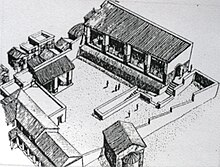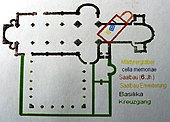Memoria (architecture)

Cella memoriae or memoria for short (Latin: memory (place) ) is the architectural name of a small building above a grave, which is dedicated to the memory of the buried. This type of memorial is also called Martyria (Greek for “testimony”). Early Christian grave structures or larger buildings are referred to as coemeterium (Greek κοιμητήριον = resting place), the synonym for “cemetery”, which can still be seen in the English cemetery and in the French cimetière .

About history
In early Christian times, the memorials of martyrs and saints (or their relics ) were called memoria or martyrion ; also memorial buildings at places of the apparition of Jesus Christ or of biblical persons like z. B. Church of the Nativity and Church of the Holy Sepulcher fall under these terms.
Memories were small structures on a square or circular floor plan, in the early days sometimes only a roof resting on four pillars. They were not used as a meeting room, but as a meeting place for prayer and as a place for commemorative and votive offerings . They can only be reconstructed archaeologically , as they were either abandoned early and fell into disrepair, or lie beneath their foundations as the nucleus of large church buildings - mostly in the middle of the crypt and exactly where the main altar is on the ground floor .
Early Christian examples in Rome
The best-known early Christian examples of a memoria in Rome include:
• Middle of the 2nd century: Petrus memoria with a marble slab and two columns above the presumed grave of the apostle Peter in Alt-St. Peter in Rome .
• Approx. 200: Cella memoria above the presumed tomb of the apostle Paul of Tarsus , donated by the Roman presbyter Gaius.
• Approx. 260: Memoria Apostolorum for the apostles Peter and Paul under the Basilica Apostolorum built there around 317 (S. Sebastiano fuori le mura).
• 3rd - 4th centuries: Martyrs' sanctuary in the Anonymous Catacomb on Via Ardeatina.
• 4th century: Memorial chapel above the grave of St. Agnes of Rome in the catacomb on Via Nomentana .

Web links
Individual evidence
- ↑ Werner Müller, Gunther Vogel: dtv - Atlas zur Baukunst I. General part: Building history from Mesopotamia to Byzantium . Deutscher Taschenbuch-Verlag, Munich 1974, p. 9
- ^ Hugo Brandenburg: Coemeterium. The change in the funeral system as a sign of the cultural upheaval in late antiquity . In: Laverna, No. 5, Scripta Mercaturae, St. Katharinen 1994, pp. 206-233
- ↑ Lexicon for Theology and Church (LThK), Freiburg 2006, Volume 7, Col. 94
- ↑ Paolo Liverani: Peter's tomb and the necropolis under St. Peter's Basilica . In: Liverani / Spinola: The necropolises in the Vatican. Stuttgart 2010, p. 47ff.
- ↑ Kristina Friedrichs: Episcopus plebi Dei. The representation of the early Christian popes . Regensburg 2015, pp. 207f.
- ↑ Hugo Brandenburg: The early Christian churches in Rome from the 4th to the 7th century , Regensburg 2013, p. 68ff.
- ↑ Vincenzo Fiocchi Nicolai: Early Christianity in "Domine Quo Vadis". The newly found early Christian basilica on the Via Ardeatina in Rome . In: Antike Welt 29 (1998), p. 310
- ↑ Ursula Leipziger: The Roman basilicas with handling. Research history inventory, historical classification and primary function , Erlangen 2006, p. 14
- ↑ Hans Georg Wehrens: Rome - The Christian Sacred Buildings from the 4th to the 9th Century - Ein Vademecum , Freiburg, 2nd edition 2017, p. 88

